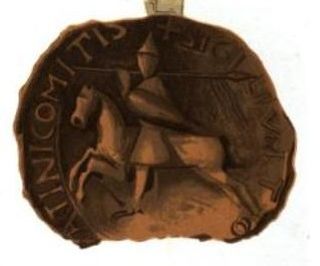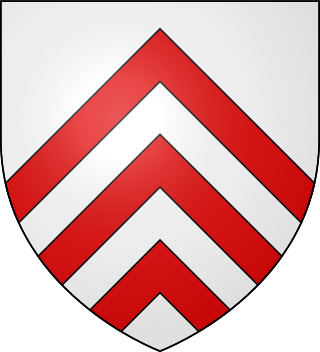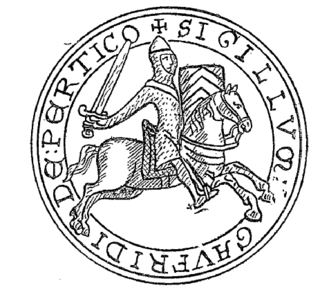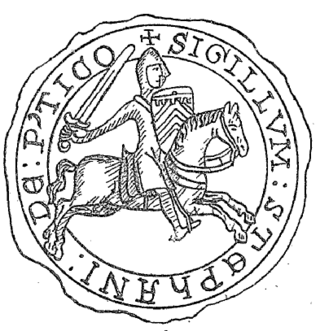
Theobald the Great (1090–1152) was count of Blois and of Chartres as Theobald IV from 1102 and was Count of Champagne and of Brie as Theobald II from 1125. Theobald held Auxerre, Maligny, Ervy, Troyes and Châteauvillain as fiefs from Odo II, Duke of Burgundy.

Odo II was Duke of Burgundy between 1143 and 1162.

Adela of Champagne, also known as Adelaide, Alix and Adela of Blois, was Queen of France as the third wife of Louis VII. She was regent of France from 1190 to 1191 while her son Philip II participated in the Third Crusade.

William III of Ponthieu also called William Talvas. He was seigneur de Montgomery in Normandy and Count of Ponthieu.

Theobald V of Blois, also known as Theobald the Good, was Count of Blois from 1151 to 1191.

Louis I of Blois was Count of Blois from 1191 to 1205. He is best known for his participation in the Fourth Crusade and later prominent role in the Battle of Adrianople.

The county of Perche was a medieval county lying between Normandy and Maine.

Matilda of Carinthia was a daughter of Engelbert, Duke of Carinthia and his wife Uta of Passau. She married Theobald II, Count of Champagne in 1123.

Rotrou III, called the Great, was the Count of Perche and Mortagne from 1099. He was the son of Geoffrey II, Count of Perche, and Beatrix de Ramerupt, daughter of Hilduin IV, Count of Montdidier. He was a notable Crusader and a participant in the Reconquista in eastern Spain, even ruling the city of Tudela in Navarre from 1123 to 1131. He is commonly credited with introducing Arabian horses to the Perche, giving rise to the Percheron breed. By his creation of a monastery at La Trappe in memory of his wife, Matilda, daughter of Henry I of England, in 1122 he also laid the foundations of the later Trappists.
Matilda of Saxony, or Richenza of Saxony was the Countess of Perche followed by the title of Lady of Coucy from the German Welf dynasty. She was also the niece of Richard the Lionheart.
The County of Châteaudun was held in the 9th century by counts who also held the County of Blois. Theobald I created the first viscount of Châteaudun with the appointment of Geoffrey I, founder of the House of Châteaudun. The viscounts were entrusted with the government of the county of Châteaudun, records of whom are continuous from the mid-10th century. The actual rule of Châteaudun between the late 9th and the mid-10th centuries, and the relationships between the count and viscounts, is uncertain. The county was revived in 1439 when the region was recreated as the County of Dunois and granted to Jean Levieux Valois des Orléans, the illegitimate son of Louis I, Duke of Orléans, son of Charles V of France.
Fulcuich(Fulcois) Count of Mortagne, son of Rotrou, Seigneur de Nogent. It has been conjectured that Fulcuich's ancestor was Hervé I, Lord of Mortagne-au-Perche, through his supposed mother, Hildegarde de Mortagne et Perche, wife of Rotrou, who is a known daughter of Hervé.
Hugues III, Viscount of Châteaudun, son of Rotrou I, Viscount of Châteaudun, and Adelise de Bellême, daughter of Guérin de Domfront. Hughes became Viscount of Châteaudun upon his father's death in 1080.
Geoffrey II, Count of Mortagne and Count of Perche, was the son of Rotrou I, Viscount of Châteaudun, and Adelise de Bellême, daughter of Guérin de Domfron. Geoffrey was Count of Mortagne and Seigneur of Nogent from 1060 to 1090, and Count of Perche from 1090 until his death.

Geoffrey III was the count of Perche from 1191 until his death.
Thomas, Count of Perche, was the son of Geoffrey III, Count of Perche, and Matilda of Saxony, daughter of Henry the Lion, Duke of Saxony and Bavaria, and Matilda of England. He died young.
William II, count of Perche and bishop of Châlons, son of Count Rotrou IV of Perche and Matilda, daughter of Count Theobald II of Champagne and Matilda of Carinthia.
John I, Count of Alençon, son of William III Talvas, Count of Ponthieu, and Helie of Burgundy.

Stephen du Perche was a French nobleman and crusader. He was a partisan of the Plantagenets in their conflict with the French crown and held fiefs from them. A younger son, he governed the County of Perche on behalf of his father and brother during their absence on crusade. He himself joined the Fourth Crusade in 1202 and travelled to the Holy Land. Afterwards, he went to the Latin Empire and was appointed duke of Philadelphia in Asia Minor in 1204. He died in battle against the Bulgars.
Elizabeth of Blois, sometimes Isabelle, was a French noblewoman, the duchess of Apulia by marriage (1143–1149) and a nun at Fontevraud.











